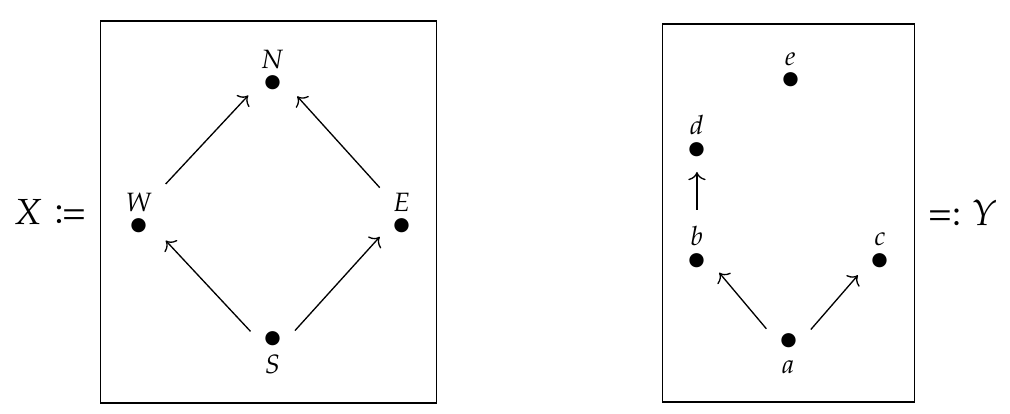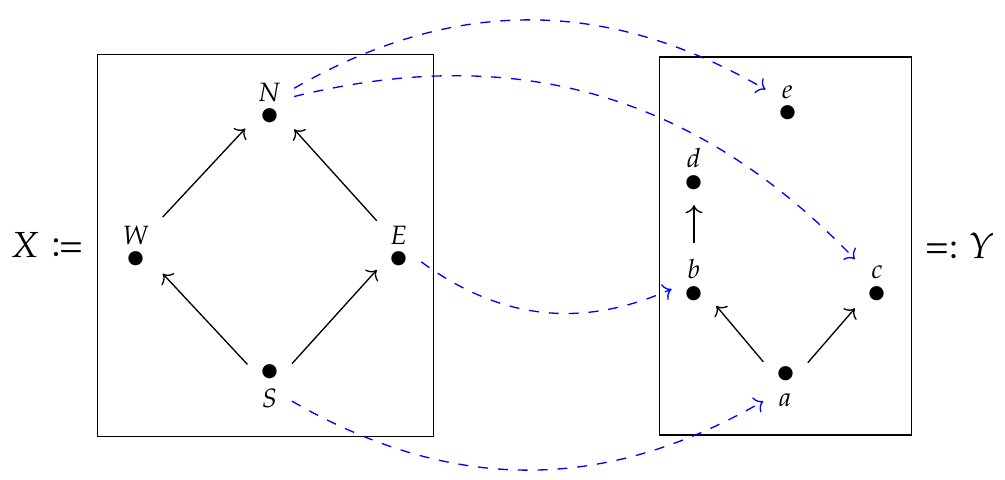 |
 |
Lecture 57 - Feasibility Relations
Let's look at some examples of feasibility relations!
Feasibility relations work between preorders, but for simplicity suppose we have two posets \(X\) and \(Y\). We can draw them using Hasse diagrams:

Here an arrow means that one element is less than or equal to another: for example, the arrow \(S \to W\) means that \(S \le W\). But we don't bother to draw all possible inequalities as arrows, just the bare minimum. For example, obviously \(S \le S\) by reflexivity, but we don't bother to draw arrows from each element to itself. Also \(S \le N\) follows from \(S \le E\) and \(E \le N\) by transitivity, but we don't bother to draw arrows that follow from others using transitivity. This reduces clutter.
(Usually in a Hasse diagram we draw bigger elements near the top, but notice that \(e \in Y\) is not bigger than the other elements of \(Y\). In fact it's neither \(\ge\) or \(\le\) any other elements of \(Y\) - it's just floating in space all by itself. That's perfectly allowed in a poset.)
Now, we saw that a feasibility relation from \(X\) to \(Y\) is a special sort of relation from \(X\) to \(Y\). We can think of a relation from \(X\) to \(Y\) as a function \(\Phi\) for which \(\Phi(x,y)\) is either \(\text{true}\) or \(\text{false}\) for each pair of elements \( x \in X, y \in Y\). Then a feasibility relation is a relation such that:
-
If \(\Phi(x,y) = \text{true}\) and \(x' \le x\) then \(\Phi(x',y) = \text{true}\).
-
If \(\Phi(x,y) = \text{true}\) and \(y \le y'\) then \(\Phi(x,y') = \text{true}\).
Fong and Spivak have a cute trick for drawing feasibility relations: when they draw a blue dashed arrow from \(x \in X\) to \(y \in Y\) it means \(\Phi(x,y) = \text{true}\). But again, they leave out blue dashed arrows that would follow from rules 1 and 2, to reduce clutter!
Let's do an example:

So, we see \(\Phi(E,b) = \text{true}\). But we can use the two rules to draw further conclusions from this:
-
Since \(\Phi(E,b) = \text{true}\) and \(S \le E\) then \(\Phi(S,b) = \text{true}\), by rule 1.
-
Since \(\Phi(S,b) = \text{true}\) and \(b \le d\) then \(\Phi(S,d) = \text{true}\), by rule 2.
and so on.
Puzzle 171. Is \(\Phi(E,c) = \text{true}\) ?
Puzzle 172. Is \(\Phi(E,e) = \text{true}\)?
I hope you get the idea! We can think of the arrows in our Hasse diagrams as one-way streets going between cities in two countries, \(X\) and \(Y\). And we can think of the blue dashed arrows as one-way plane flights from cities in \(X\) to cities in \(Y\). Then \(\Phi(x,y) = \text{true}\) if we can get from \(x \in X\) to \(y \in Y\) using any combination of streets and plane flights!
That's one reason \(\Phi\) is called a feasibility relation.
What's cool is that rules 1 and 2 can also be expressed by saying
[ \Phi : X^{\text{op}} \times Y \to \mathbf{Bool} ]
is a monotone function. And it's especially cool that we need the '\(\text{op}\)' over the \(X\). Make sure you understand that: the \(\text{op}\) over the \(X\) but not the \(Y\) is why we can drive to an airport in \(X\), then take a plane, then drive from an airport in \(Y\).
Here are some ways to lots of feasibility relations. Suppose \(X\) and \(Y\) are preorders.
Puzzle 173. Suppose \(f : X \to Y \) is a monotone function from \(X\) to \(Y\). Prove that there is a feasibility relation \(\Phi\) from \(X\) to \(Y\) given by
[ \Phi(x,y) \text{ if and only if } f(x) \le y .]
Puzzle 174. Suppose \(g: Y \to X \) is a monotone function from \(Y\) to \(X\). Prove that there is a feasibility relation \(\Psi\) from \(X\) to \(Y\) given by
[ \Psi(x,y) \text{ if and only if } x \le g(y) .]
Puzzle 175. Suppose \(f : X \to Y\) and \(g : Y \to X\) are monotone functions, and use them to build feasibility relations \(\Phi\) and \(\Psi\) as in the previous two puzzles. When is
[ \Phi = \Psi ? ]
To read other lectures go here.
 |
 |